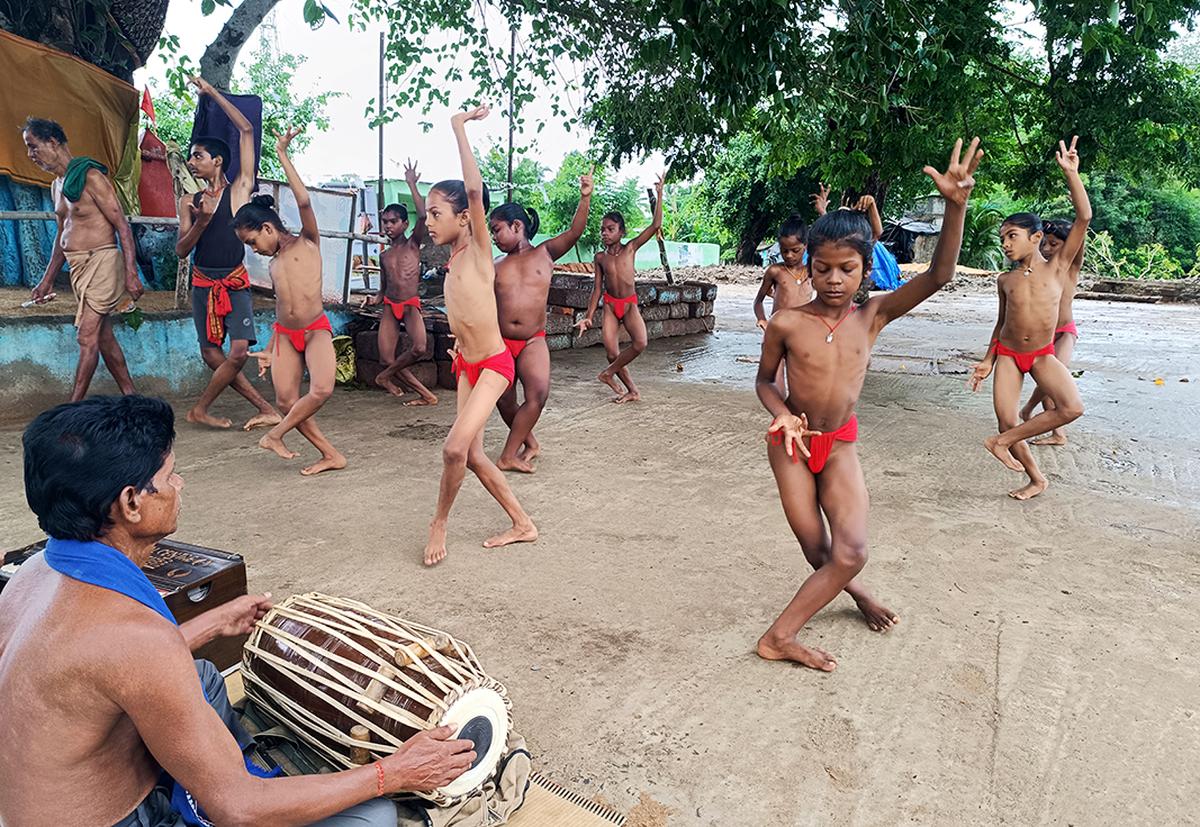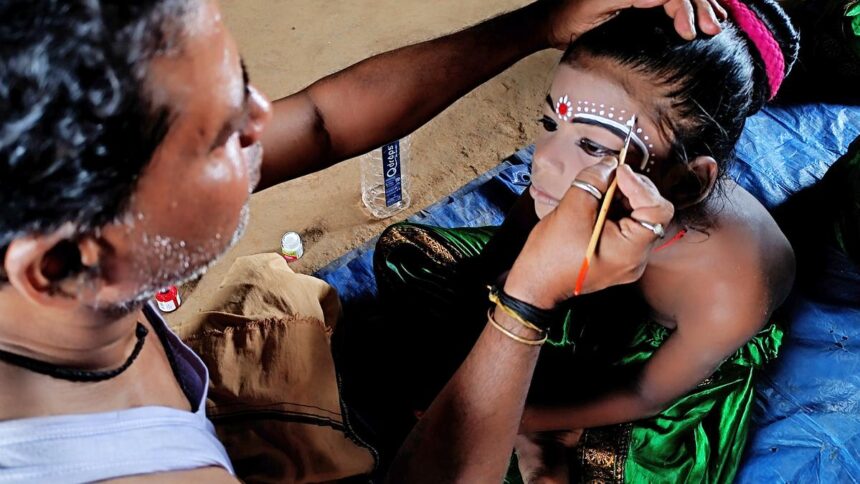[ad_1]
Sradhananda Behera’s hands move with a rhythm, as he mixes cement and sand at a construction site in Odisha’s coastal district of Puri. In his early 20s now, Sradhananda’s mind goes back to the days he had danced in France, Morocco, and Portugal — a journey unimaginable for most in his village.
His brother, Gadadhar Behera, now 27, had also felt the thrill of international applause and the bustle of foreign airports. Today, he drives a tractor, transporting construction material across their village in Piteipur, just 20 kilometres from Puri town.
“The guru [who is also the troupe manager] would organise performances in India and abroad,” says Gadadhar, who now earns Rs. 300 a day.
In this traditionally revered boys-only dance form, a child’s journey as an artiste often concludes at puberty, leaving them without the education required for an office job or the skills for a tradesperson.
Now, akhadas , where boys are nurtured into graceful dancers, are finding it difficult to attract disciples.

Young Gotipua dancers are seen as they are practicing Gotipua Dance at Gurukul at Khajuria village in Odishas Puri district.
| Photo Credit:
Biswaranjan Rout
There are approximately 10 to 15 akhadas in Odisha where Gotipua is taught in the traditional gurukul style, though most of them are non-residential. Each one has four to five students, all under the age of 14. About 30 years ago, there used to be about 20 students at the each akhada .
The journey for Gotipua dancers involves over 20,000 hours of rigorous training spanning 10 years, dressing as girls on stage, sacrificing their education, and staying away from their families.
Children are initiated into the practice as early as five. By the time they are 16 and their bodies change, complex hand and body movements that require suppleness become difficult. That is their age of ‘retirement’.
The few parents, who do send their children to learn, do so for reasons other than upholding a cultural practice. Sushant Kumar Behera, a daily wager in Puri district, is happy to send his son Sudhir, a fourth-grader, to learn Gotipua.
“It is difficult for me to pay my son’s school fee, the gurukul is bearing the expense,” he says.
Tradition troubles
Young Gotipua dancers are being massaged with oil, a routine, at Gurukul at Khajuria village in Odishas Puri district.
| Photo Credit:
Biswaranjan Rout
Gotipua, which translates to ‘one boy,’ has children trained in singing, dancing, yoga, and acrobatics within gurukuls or akhadas . They dress as girls and perform at temple festivals, social gatherings, and religious ceremonies. Originating in the 16th century, Gotipua is celebrated as the precursor to the classical Odissi dance form.
At an art exhibition titled ‘Boy Dancer’ organised by New Bridge India, a non-profit cultural initiative, and the Odisha State Museum in Bhubaneswar in the recent past, Gotipua aficionados wondered about the future of the dance and its dancers.
Birendra Pani, a contemporary visual artist, poignantly captured the essence of Gotipua dancers in his artwork, presenting their images framed with blades.
“The blades suggest the risk of being a Gotipua dancer,” Pani explains. “These young performers are constantly on the edge, facing the harsh reality that once they reach the age of 16, securing a means of livelihood becomes a challenge,” he says.
Young Gotipua dancers are seen as they are practicing Gotipua Dance at Gurukul at Khajuria village in Odishas Puri district.
| Photo Credit:
Biswaranjan Rout
In the past, parents would entrust their sons to akhadas to receive education in dance and be provided with meals. It was also a common practice for parents to dedicate their children to deities, expecting to receive blessings for their children’s good health and well-being. Additionally, gurus would travel to various villages to scout for talented boys. They would persuade parents to allow their children to join and train in Gotipua.
Chitta Ranjan Malia, who has a PhD in Gotipua, says, “After the advent of Sri Chaitanya [considered a Hindu saint and Krishna devotee], Vaishnavism was in full swing in Odisha in the 16th century. The Vaishnavites [Krishna is considered an avatar of Vishnu] had, however, not approved of dancing by women. Instead, they preached and practised the cult of Sakhi Bhava or offering oneself to Krishna as a female attendant, and introduced boy dancers. The dance later developed its technique, style, and presentation.”
Temple dances performed by devadasis or maharis (women dedicated in childhood to deities) were brought outside the temple by male dancers dressed as women, says Malia.
He adds that initially Gotiupa was performed within the temple precincts and only during festivals, but soon the dance became a popular form of entertainment outside the temple, especially in rural areas.
The Gotipua gurukul
About 80 km from Odisha’s capital city of Bhubaneswar lies Khajuria, a village in the Brahmagiri block of Puri district. Khajuria hosts a gurukul , its asbestos roof sheltering a dimly lit hall built from laterite stones.
Young Gotipua dancers are seen as they are practicing Gotipua Dance at Gurukul at Khajuria village in Odishas Puri district.
| Photo Credit:
Biswaranjan Rout
Despite its gloom, the hall comes alive in the early morning hours. Om Sai Prasad Behera, an 11-year-old boy, is dropped off by his father, just as other children like Dipti Ranjan Behera arrive. By 4.30 a.m., 15 children, all under 14, begin their day with the rehearsal of devotional songs. This is considered a thriving akhara , because of the number of children.
As dawn breaks, Gautam Kumar Mahapatra, the 47-year-old guru, steps into view, wearing the loincloth of practice. After a brief session of a sesame oil massage, the children prepare for a series of nine yoga and acrobatic exercises. These include mastering balance on their toes and performing headstands.
As the morning progresses, Mahapatra instructs the children to move to the next level of practice: dance movements.
“The footwork required for Gotipua is fundamental,” he says. “The dancers learn stillness and poise.”
Disciples resume their regular schedules by attending tutoring sessions to keep pace with their school curriculum. After school, the Gotipua dancers recommence their practice sessions, refining both their singing and dancing skills in the evening.
“I watched the Gotipua performers when I was very young. I was drawn to it, and my father had no hesitation in sending me to the gurukul ,” says Dipti, a fourth-grade student whose father is a bus driver near Khajuria.
“Gotipua stands out as a dance form where each dancer sings while performing, demanding exceptional breath control. However, this is fading as modern Gotipua performances increasingly rely on pre-recorded or live songs sung by others, with the dancers merely miming to the music,” says Priyambada Mohanty Hejmadi, who has authored Gotipuas: The Boy Dancers of Odisha .
While traditional gurukuls are typically residential, where students live and learn under the direct supervision of their gurus, the one managed by Mahapatra in Khajuria is a rare institution that tries to blend tradition with the demands of modern learning.
Mahapatra expresses concern: “As a trained Gotipua dancer, I am committed to ensuring that this art form does not fade away during my lifetime, but my gurukul struggles to generate enough revenue to support my family, let alone provide for the parents of Gotipua dancers to maintain their enthusiasm.”
Young Gotipua dancers are seen as they are practicing Gotipua Dance at Gurukul at Khajuria village in Odishas Puri district.
| Photo Credit:
Biswaranjan Rout
He rues that the government has not developed a plan or funding to keep the dance form alive. Gurus do not charge their students; what they earn is from stage performances, and this covers training and tuition fee.
Then and now
Historically, Gotipua gurukuls flourished under the patronage of kings and zamindars. In the 20th century, efforts were made to formalise and structure Gotipua, leading to the establishment of Odissi as a distinct and systematic dance form.
However, very few dancers make the transition to Odissi, which is centred in urban areas and is woman-focused.
When they leave Gotipua behind, securing a job based solely on academic performance is challenging. “Throughout our school years, we undergo intense training, leaving us fatigued and unable to focus on studies,” says Sradhananda. “When stage performances clashed with school schedules, we were often required to prioritise dance over academics.”
Sanjay Jena, another Gotiupa dancer from Balipokhari village in the Brahmagiri block of Puri, reflects on his journey. “After 15 years of dancing and touring various parts of the country, my career eventually came to an end. I was left hopeless. Now, I work as a driver, struggling to make a decent living,” he shares.
Rajashree Biswal, an art researcher working on Gotipua dancers for the past two decades, talks about the way they have been depicted visually to “show the dancers’ vulnerability…with bruises, cuts on their fingers, and musical anklets in disarray to evoke an emotional response from the viewers”.
With boys increasingly hesitant to pursue Gotipua, girls have begun to take it up, sparking objections from ‘purists’ who feel this alters the essence of the dance, because traditionally, women during their menstrual cycles are excluded from temples and religious ceremonies.
Kaveri Palei, a 24-year-old Gotipua dancer from Puri district, says it’s a natural dance for women. “Certain eyebrow movements and poses are uniquely suited to girls,” she says, adding that there has been resistance, but things are changing over time.
What lies ahead
Gurupada Baliyarsingh, secretary of the Gotipua Sangha, is striving to secure government support. “There is limited awareness of the dance and the challenges of Gotipua troupes, even within Odisha. These groups often face scrutiny under the Juvenile Justice Act [2015] and are sometimes detained at railway stations and airports,” he says.
He says the boys sometimes wait until they turn 50 to qualify for pension under the Mukhyamantri Kalakar Sahayata Yojana (MKSY) that gives artists Rs. 2,000 per month. This delay leaves them vulnerable for decades, without a reliable safety net.
Malia, who was also the secretary of the Odisha Sangeet Natak Akademi from 2012-2014, suggests integrating Gotipua with Odissi dance.
“If Gotipua is established as Odissi’s foundation course, it would help in the seamless transition of Gotipua dancers into a classical form,” he says.
Dilip Routrai, Director of Culture, says the government has come up with the Cultural Troupe Management System (CTMS) through which dance groups can apply for assistance for their stage performances.
“The government is ready to pay travelling allowance and dearness allowance besides the expenditure incurred on stage performances. We want to promote the Odisha culture,” the Director says. Meanwhile, in Khajuria, Mahapatra desperately seeks opportunities for stage performances, whether government-sponsored or private, to sustain the young dancers and himself, in an effort to keep the tradition alive.
[ad_2]
Source link







